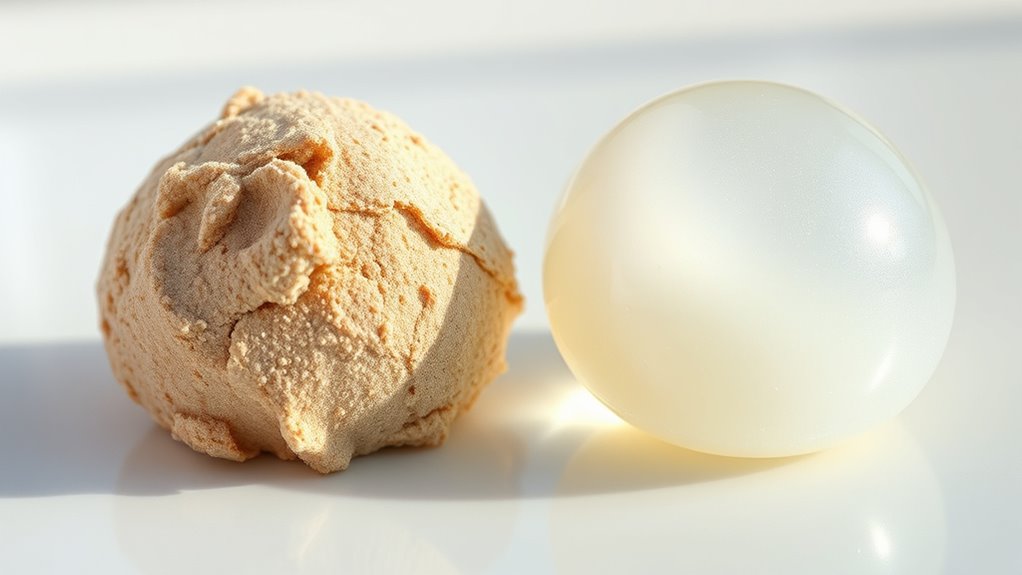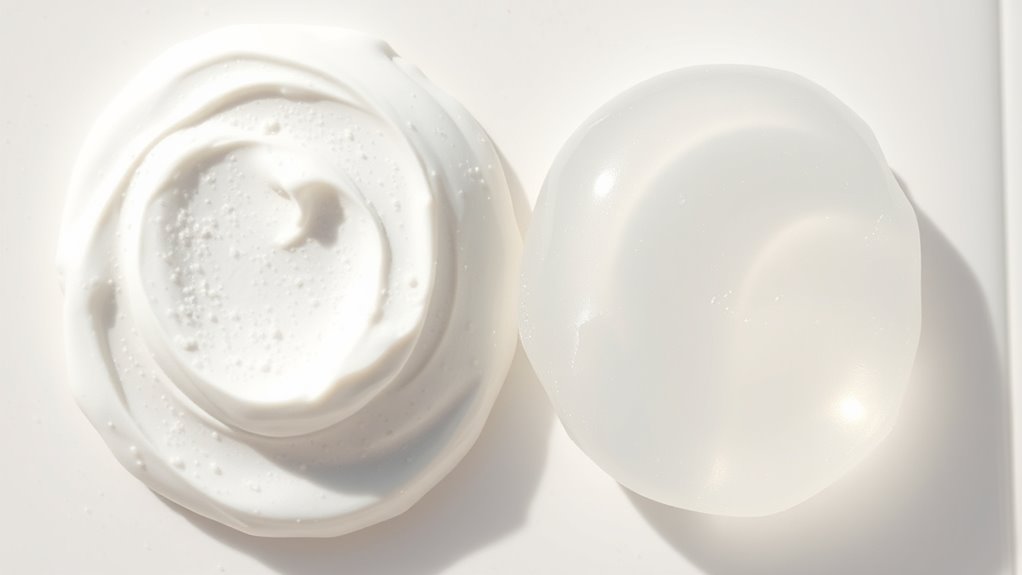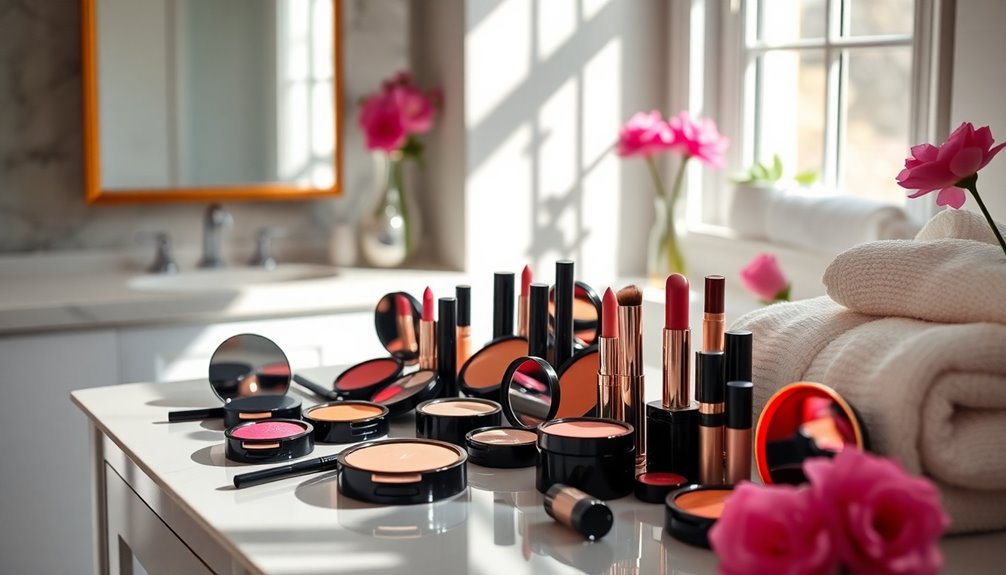When choosing between mineral and chemical sunscreens, consider your skin type and preferences. Mineral sunscreens use ingredients like zinc oxide or titanium dioxide to reflect UV rays, making them gentler and better for sensitive skin. Chemical options absorb UV rays, are lightweight, and often blend more easily. If you want to learn more about which type suits you best and how they compare, there’s more valuable information to explore below.
Key Takeaways
- Mineral sunscreens reflect UV rays with ingredients like zinc oxide, while chemical sunscreens absorb UV rays and convert them into heat.
- Mineral options sit on the skin surface providing immediate protection, whereas chemical sunscreens require absorption time to be effective.
- Mineral sunscreens are gentler on sensitive skin and less likely to cause irritation or allergic reactions.
- Mineral sunscreens may leave a white cast and are preferred for natural looks; chemical sunscreens are lighter and easier to apply.
- Mineral ingredients are considered safer with less synthetic exposure, and they are more stable and longer-lasting in sunlight.

When choosing a sunscreen, understanding the difference between mineral and chemical options is essential for protecting your skin effectively. Mineral sunscreens, often made with natural ingredients like zinc oxide or titanium dioxide, act as physical blockers that sit on the surface of your skin. These ingredients reflect and scatter UV rays, providing a barrier that starts working immediately upon application. Because of their natural composition, mineral sunscreens are generally considered gentler on sensitive skin and are less likely to cause irritation or allergic reactions. If you have skin sensitivity or allergies, mineral sunscreens are usually the safer choice, as they contain fewer synthetic ingredients that might trigger adverse reactions. Their simplicity and natural ingredients make them popular for those seeking a more organic approach to sun protection.
Chemical sunscreens, on the other hand, contain ingredients like avobenzone, oxybenzone, or octocrylene that absorb UV rays and convert them into heat, which your body then dissipates. These formulas tend to be more lightweight, easier to apply, and often less visible on the skin, making them popular for daily use and for those who dislike the white cast sometimes left by mineral options. However, chemical sunscreens often contain synthetic ingredients, which can sometimes cause irritation, especially for individuals with sensitive skin. If your skin is prone to reactions or if you have concerns about potential long-term effects of certain chemicals, chemical sunscreens may not be the best choice. It’s important to check the ingredient list carefully and choose formulations that are free of known irritants.
When considering natural ingredients, mineral sunscreens stand out because they rely on physical filters rather than synthetic chemicals. They tend to be more stable in sunlight, meaning they don’t break down as quickly, providing longer-lasting protection. Additionally, natural ingredients in mineral sunscreens are less likely to penetrate the skin and cause hormonal disruptions or other health issues sometimes associated with chemical filters. If you prioritize products with fewer synthetic components and want to reduce the risk of skin sensitivity, mineral sunscreens are a reliable option. They’re also preferred by those with skin conditions like rosacea or eczema, as they generally cause less flare-ups.
Frequently Asked Questions
Can Mineral Sunscreens Cause Skin Irritation for Sensitive Skin?
Yes, mineral sunscreens can cause skin irritation for sensitive skin, but they’re generally gentler than chemical options. Mineral sunscreens contain ingredients like zinc oxide or titanium dioxide, which are less likely to irritate. However, if you have very sensitive skin, look for formulas labeled “hypoallergenic” or “for sensitive skin.” Always patch-test new products and choose mineral sunscreens free from added fragrances or dyes to minimize the risk of skin irritation.
How Long Does Mineral Sunscreen Typically Last on the Skin?
Did you know that mineral sunscreen’s SPF can last around 2 hours on your skin? You should reapply sunscreen every two hours, especially after swimming or sweating, to maintain SPF longevity. Mineral sunscreens form a physical barrier, so their effectiveness is relatively consistent, but reapplication is essential for continued protection. Always follow label instructions for the best results, and remember, reapplication keeps your skin safe from UV damage.
Are Chemical Sunscreens More Effective Against UVB or UVA Rays?
Chemical sunscreens are generally more effective against UVB protection, which causes sunburn, but their UVA efficacy can vary. Some formulations provide strong UVA coverage, helping prevent skin aging and long-term damage. You should look for broad-spectrum labels to guarantee both UVB and UVA rays are blocked effectively. Applying enough sunscreen and reapplying regularly is key to maintaining protection, especially during prolonged sun exposure.
Do Mineral Sunscreens Leave a White Cast on Darker Skin Tones?
You might worry about a white cast with mineral sunscreens, and yes, they can leave one on darker skin tones. But don’t throw the baby out with the bathwater; many modern mineral formulas now come tinted or are formulated to blend seamlessly. It’s worth trying different brands to find one that matches your skin tone better, so you stay protected without feeling like you’re wearing a mask.
Can Chemical Sunscreens Be Absorbed Into the Bloodstream?
Chemical sunscreens can be absorbed into your bloodstream, raising absorption concerns. Studies show ingredients like avobenzone, oxybenzone, and others may enter your blood after application. While short-term safety data is reassuring, long-term effects remain uncertain. If you’re worried about bloodstream safety, consider mineral sunscreens, which sit on your skin rather than absorbing. Always follow usage instructions and consult your dermatologist if you have specific health concerns.
Conclusion
Choosing between mineral and chemical sunscreen depends on your skin and lifestyle. Did you know that studies show mineral sunscreens are effective immediately after application, offering protection in just 15 minutes? This quick action can be a game-changer for busy mornings. Whether you prefer the natural barrier of zinc oxide or the lightweight feel of chemical filters, understanding their differences helps you make the best choice. Protect your skin confidently—your health depends on it.










